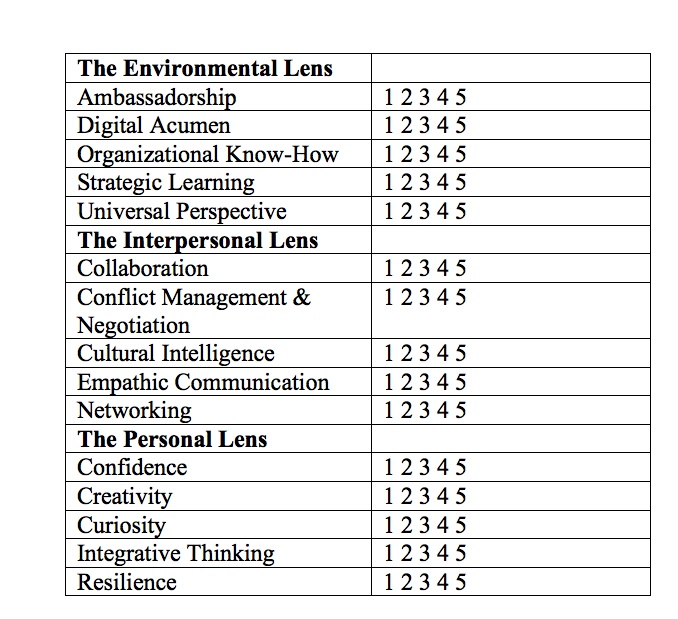
Clearly, the world and our organizations are in deep flux these days. Technology and other disruptive forces have greatly accelerated the rate of change. Our frameworks must change, too, as new realities disrupt our organizations and the people who work in them. Complexity, like rust, never sleeps, and we must occasionally audit our frameworks for their continued usefulness.
I published a framework of global leader competencies back in 1997 (“The Global Leader: Critical Factors for Creating the World-Class Organization,” McGraw-Hill). Called the Global Leadership Triad, the model was developed after I conducted interviews with executives in several global companies. The Triad proved to be useful for many clients for quite some time, but I can’t in good conscience continue to apply it like it contains immortal truths about what it takes to be a global leader. There was, for example, no consideration for the impact that technology has had on leading across borders or the importance of collaborative leadership in leveraging global talent.
My latest bright and shiny model of global leadership is called The Three Lenses (I dropped “Triad” after some complained that I was associating global leadership with Chinese organized crime).
The Three Lenses framework consists of the following:
The Environmental Lens looks at global leadership from a macro perspective. What competencies do I need to lead effectively in a global company within a global environment? Competencies in this set are:
- Ambassadorship: Acts as role model for the global corporate culture and values, while ensuring that local cultures are respected and taken into account for motivating employees and satisfying customers.
- Digital Acumen: Utilizes big data and the push and pull communication capabilities of new technologies to connect, engage, and leverage collective intelligence.
- Organizational Know-How: Knows how to get things done by capitalizing on capabilities and resources from across the enterprise and beyond.
- Strategic Learning: Engages in ongoing strategy making through continuous inquiry and analysis of changes and trends in the global business environment.
- Universal Perspective: Weighs global (standardized) and local (specific) goals to make decisions that generate optimal results for the business.
The Interpersonal Lens looks at global leadership from a group perspective. What competencies do I need to lead effectively across geographic, cultural, and other borders?
- Collaboration: Works together with others across borders and distances to create new value for the business. The collaboration could take several forms—virtual project teams, communities of practice, and/or social networks.
- Conflict Management and Negotiation: Manages conflict constructively in a problem-solving rather than confrontational way, and builds agreements across differences.
- Cultural Intelligence: Develops and maintains productive relationships across cultural groups through cultural awareness, knowledge, strategy, and action.
- Empathic Communication: Seeks first to understand and then be understood. Listens to learn. Attempts to look at the world through the eyes of others.
- Networking: Reaches out across boundaries to form strong and weak ties that enable the rapid flow of knowledge and expertise to support individual or shared goals.
The Personal Lens looks at global leadership from an individual perspective. What competencies do I need to lead effectively in this new world?
- Confidence: Believes he or she can make things work out and get results despite unfamiliarity, uncertainty, and complexity. To succeed, the global leader must be confident while avoiding arrogance.
- Creativity: Applies imagination and improvisation in situations that have not been encountered before. Is willing to experiment and adapt.
- Curiosity: Creates opportunities to learn about self and others through training or real-world experience and reflection. Is not satisfied with surface understanding that can be misleading and destructive.
- Integrative Thinking: Understands the limitations of either/or thinking in a complex world full of dilemmas. He or she looks at the organization through a systems lens and recognizes interrelationships within the business, and between the business and the wider environment, e.g., geopolitics.
- Resilience: Keeps going when setbacks occur. Always adopts a learning mindset in unfamiliar situations, and stays calm and controlled. Looks for a way forward rather than give in to anxiety and stress.
How do you rate the leaders in your business who are considered to have global responsibilities? How do you rate yourself?
1 = Very Poor
2 = Poor
3 = Fair
4 = Good
5 = Very Good

As someone who is most likely in a Learning & Development role, what do you see as the learning priorities (in The Three Lenses) for those you are developing as global leaders?
What do you see as the most impactful and cost-effective learning experiences for each of those priorities?
Terence Brake is the director of Learning & Innovation, TMA World (http://www.tmaworld.com/training-solutions/), which provides blended learning solutions for developing talent with borderless working capabilities. Brake specializes in the globalization process and organizational design, cross-cultural management, global leadership, transnational teamwork, and the borderless workplace. He has designed, developed, and delivered training programs for numerous Fortune 500 clients in the United States, Europe, and Asia. Brake is the author of six books on international management, including “Where in the World Is My Team?” (Wiley, 2009) and e-book “The Borderless Workplace.”



